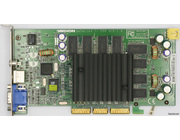The third generation GeForce: NV20 is the 'vanilla' and first version of the GeForce 3 series. Other models; the Ti200 which is slower, and the Ti500 which is faster exist too.
nVidia released the Zoltar techdemo for the GeForce 3 to show it's capabilities and programmable shaders. In the past nVidia also wrote demo's for the GeForce 256 and the GeForce 2 but in my opinion the Zoltar-techdemo is the first mature one. All the other demo's were just used to show examples of new techniques or possibilities where Zoltar is actually interactive.
The NV2A is based upon the NV20 and is used in the Xbox.
The MSI 8838 is also known as the Medion GeForce 3 Ti200 that was sold in the Medion PC's at supermarket concern Aldi. If I remember correctly these were paired up with a Pentium 4 1800MHz.
I have two of these cards, the other one has been benchmarked here.
Later models of the Medion GeForce 4 Ti based cards usually had slightly lower clock frequencies. However, the Medion GeForce 3 Ti200 is clocked at stock Ti200 frequencies ![]() . > Read more
. > Read more
A nice specimen of the GeForce 3 Ti 200. Not equipped with a DVI connector to save costs but decent cooling on the chip and memory. I have a couple of GeForce 3 cards and this is the only one with 128MB RAM. The standard GeForce 3's have 64MB RAM which basically is enough for the games of that era. > Read more
This passive cooled GeForce3 Ti200 is build by MSI and was used in a Medion system. When it was new the GeForce3 Ti200 could be considered a mid/high-end card.
Both the Ti200 and Ti500 are newer than the original GeForce3. > Read more
The GeForce 3 is a DirectX 8 compliant 3D-card and brought new features and techniques to the market. It has programmable shaders, LMA (Lightspeed Memory Architecture) for better memory management, reducing overdraw en compression of the Z-buffer. In terms of image quality the GeForce 3 can do better anti-aliasing and 8-tap anistropic filtering. The GeForce 2 could only do 2-tap and instead of 'real' anti-aliasing the GeForce 2 rendered a high resolution and scaled it back to get less 'jaggies'.
Performance-wise the GeForce 3 is quite good but sometimes it's surpassed by the older GeForce 2 Ultra. The GeForce 2 Ultra has higher clock-frequencies and more memory bandwidth. Because both the GeForce 3 and GeForce two have four pixel pipelines which each can sample two textures per clock the GeForce 2 Ultra has an higher pixel and texel fill-rate. This causes the GeForce 2 Ultra to score higher in Quake 3 16-bits where the GeForce 3 excels (by quite a margin) in more advanced benchmark/games like Aquamark 3 or Unreal Tournament 2003. The effect of LMA clearly shows in Quake 3 on higher resolutions and 32-bit color as the GeForce 3 keeps pretty strong and the GeForce 2 Ultra pant for extra memory bandwidth.
Both the GeForce 3 Ti200 and Ti500 were released at a later date (October 2001). The original GeForce 3 Ti is positioned between them. > Read more



